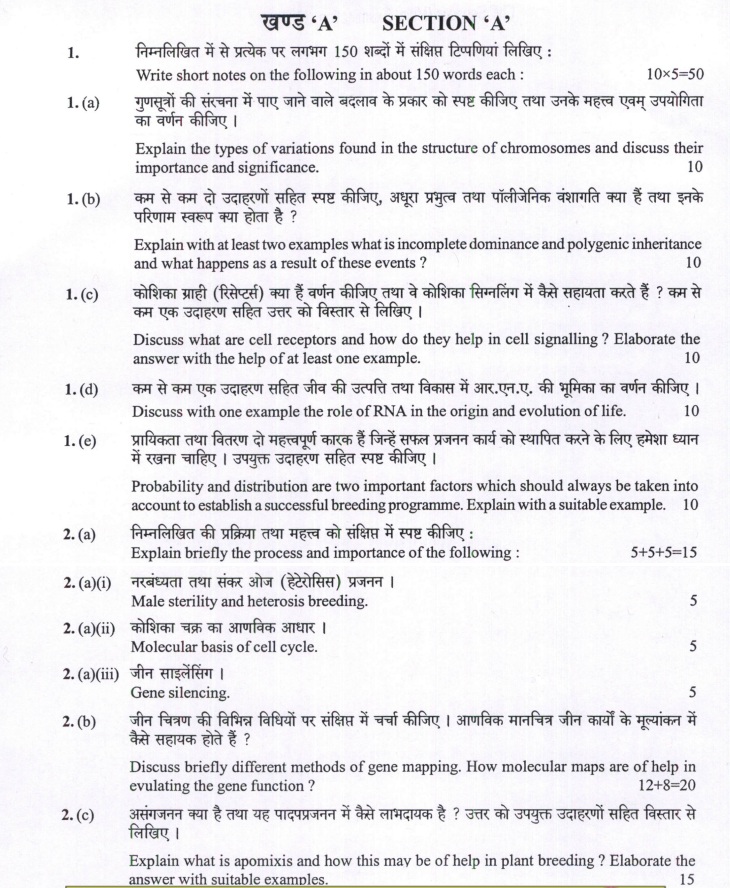(HOT) UPSC Current Affairs 2025 PDF
NEW! The Gist (NOV-2025) | E-BOOKS
(Download) UPSC MAIN EXAM : 2024 BOTANY (Paper-2)
(Download) CS (MAIN) EXAM:2024 Botany (Paper II)
-
Exam Name: CS (MAIN) EXAM:2024 Botany (Paper II)
-
Marks: 250
-
Time Allowed : Three Hours
खण्ड 'A' SECTION ‘A’
1. Write short notes on the following in about 150 words each : 10 × 5 = 50
1. (a) Explain the types of variations found in the structure of chromosomes and discuss their importance and significance.
1. (b) Explain with at least two examples what is incomplete dominance and polygenic inheritance and what happens as a result of these events?
1. (c) Discuss what are cell receptors and how do they help in cell signalling? Elaborate the answer with the help of at least one example.
1. (d) Discuss with one example the role of RNA in the origin and evolution of life.
1. (e) Probability and distribution are two important factors which should always be taken into account to establish a successful breeding programme. Explain with a suitable example.
2. (a) Explain briefly the process and importance of the following:
2. (a) (i) Male sterility and heterosis breeding.
2. (a) (ii) Molecular basis of cell cycle.
2. (a) (iii) Gene silencing.
2. (b) Discuss briefly different methods of gene mapping. How molecular maps are of help in evulating the gene function?
2. (c) Explain what is apomixis and how this may be of help in plant breeding? Elaborate the answer with suitable examples.
3. (a) Describe along with illustrated diagrams the structure and function of mitochondria and endoplasmic reticulum.
3. (b) (i) Explain with example how male sterility is related to cytoplasmic inheritance?
3. (b) (ii) Discuss in brief the molecular basis of sex determination in plants.
3. (c) Explain the process of protein synthesis in plants and write a note on the structure and function of proteins.
4. (a) Discuss briefly the following and comment on their significance: 10+5+5=20
4. (a) (i) In what way the transfer of genes in plants help in their sustainable development ? Support the answer with an example.
4. (a) (ii) Importance of biosafety aspects of transgenic crops.
4. (a) (iii) Polytene chromosomes.
4. (b) Explain how mass selection will be of help in a successful breeding program. Elaborate the answer with a suitable example.
4. (c) Briefly discuss various theories of organic evolution. Support the answer with a suitable example and evidence.
खण्ड 'B' SECTION 'B'
5. Write short notes on the following in about 150 words each : 10×5=50
5. (a) Explain what is secondary active transport. Discuss its importance in ion acquisition in plants.
5. (b) Discuss what is GOGAT? Comment on its catalytic function.
5.(c) Regulation of seed dormancy and germination by phytohormones.
5. (d) Metallophytes and their practical importance.
5. (e) Invasive alien species and their impact on biodiversity.
6. (a) Explain the compartmentation of biochemical reactions in photorespiration. Comment upon the significance of the process.
6. (b) Describe the structure of phytochrome. Explain its mode of action in flowering plants.
6. (c) Give a concise account on altitudinal zonation of vegetation with special reference to Himalayan Vegetation.
7. (a) Define leaf senescence. Describe important physiological and biochemical changes taking place during this process. Comment upon the regulation of senescence by phytohormones.
7. (b) Describe the molecular organization of chloroplast ATP synthase. Explain its mechanism of action.
7. (c) (i) Discuss the causes, consequences and control of eutrophication.
7. (c) (ii) In present Indian scenario, explain the importance of biosphere reserves in bio-diversity conservation.
8. (a)(i) What are allosteric enzymes? Explain in detail on the allosteric enzyme modulation. 8
8. (a) (ii) Describe the process of gluconeogenesis and its significance.
8. (b) What is environmental management? Discuss various control measures to minimize environmental pollution.
8. (c) Differentiate between mutualism and commensalism by citing two examples for each of them.




